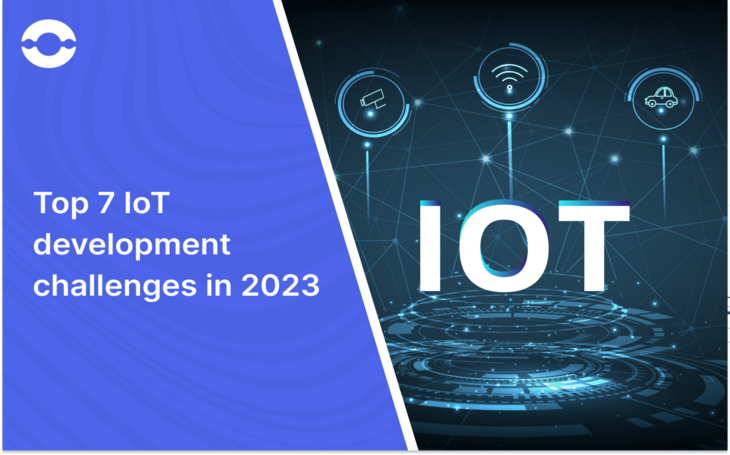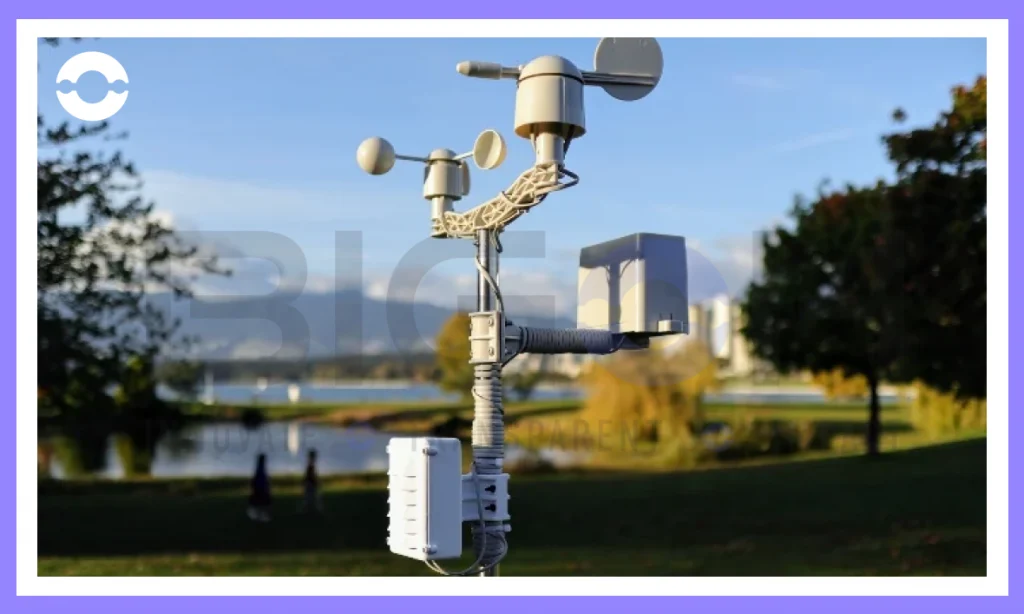
A market forecasted to reach $6.5 trillion by 2024, IoT is certainly making some rapid progress. Initially viewed as just a technology that connects some devices to the internet, with restricted applications and security issues, IoT outgrew these limitations and matured with time. The benefits of this technology are ample. But just like everything in life comes with its pros and cons, there are some IoT development challenges, that we are going to learn about in this blog.

Let’s quickly look at these challenges and the ways to work around them.
7 Common Challenges of IOT Development
Every software or product development goes through some bottlenecks or hiccups due to multiple functional and non-functional factors. Similarly, there are certain challenges in IoT implementation as well.

Although the benefits outweigh the challenges, developers, and businesses should be aware of them to take more informed and conscious decisions.
The list of IoT development challenges is as follows:
1. Security Woes

Multiple cyber-attacks have been reported on IoT devices in the past, exposing the susceptibility of development code to a wide range of vulnerabilities and unauthorized access. This makes security one of the biggest IoT development challenges.
IoT devices have a limited power supply. Additionally, they are run in the field on a single charge for a long time, perhaps a few years. As a result, there emerges a need for transmitting and receiving the data with very less power.
Therefore, adding encryption, authentication, and other security protocols tends to increase the power consumption of basic transmissions. Unfortunately, a lot of IoT devices do not possess these capabilities.
Furthermore, over time, the device firmware is exploited by emerging technologies and techniques. Owing to this reason, vulnerabilities, if any, are not discovered and keep on accumulating in the absence of an update. Why not simply update and solve all the worries?
IoT devices are usually too distributed and directly non-accessible for manufacturers to carry out on-site updates. In addition, remote firmware updates sometimes tend to consume large amounts of power if the device doesn’t have enough data throughput.
On top of it all, if the device relies on the network infrastructure of the end user, it becomes excessively vulnerable to cyber-attacks, and other devices and applications on the network may be accessed using it.
Quick Tips:
- Engagement with a security expert during the development process of an IoT device is extremely important.
- Further ensuring that the communication stack between the IoT device and the cloud along with the blackened stack is checked for vulnerabilities on a regular basis.
- Cellular IoT offers a shield against some of the security issues. These networks authenticate devices through SIM cards. Moreover, security features such as IMEI locks. These security measures ensure that only the intended device makes use of a particular SIM card. Remote firmware updates using minimal power. Is also possible through these networks.
2. Development Costs
The infrastructural requirements of an IoT device come with high costs and hence, is considered one of the IoT development challenges. Additionally, there are some hidden costs. Moreover, costs to update, maintain, design and deploy, replacing obsolete devices, etc., can accumulate over time.
There is another issue that leads to higher costs of development i.e., the hassle to find the right development team with the required skill and expertise.
However, there is a hope that gradually the infrastructure would catch up and grow in tandem with the technology and the costs would come down. Furthermore, as more and more businesses explore and invest in IoT, this problem is bound to vanish!
For example, BigOhTech specializes in IoT app development services.
It has a dedicated development team consisting of IoT developers and designers who ensure that the device is carefully designed, and thoroughly tested for all potential vulnerabilities or shortcomings, ensuring faster time to market.
3. Infrastructure and Reliability

However expensive, infrastructure or hardware requirements cannot be overlooked or taken lightly. A solid and secure infrastructure makes a product worth the investment. And this requires significant investments.
There are cheap sensors readily available in the market, that are also interestingly, effective. However, their reliability and longevity cannot be ensured. And the ones that are reliable do not come at lower prices.
Moreover, their upkeep demands certain investments as well, especially when they are intended to be used for delicate operations. Otherwise, the data generated by them would not be accurate and hence, reliable.
Therefore, the availability of the resources might not match the hardware requirements. This fact must be borne in mind before taking up any IoT project.
Additionally, the designs and development should be such that the IoT device could withstand and function properly in harsh environments as well, avoiding device failures and ensuing reliability.
Quick tips:
- Prioritizing reliability throughout the development process is essential.
- Suitable investments should be made in robust and reliable hardware and software designs.
- Regular testing and maintenance efforts are necessary to identify issues and find resolutions to them.
- Implementation of redundant systems and failover mechanisms to ensure the device continues to function even in the event of a failure, is important.
4. Ease of Integration and Battery Life
One of the topmost IoT development challenges includes the integration of these devices with existing systems and software. Integration with different platforms, operating systems, cloud services, and legacy systems, can be a bit of a hassle. Non-integration means that the device is not usable enough or optimal and may not support business operations and practices as well as survive technical advancements.
Furthermore, majority of the IoT devices come with small batteries and short battery life. And as technology is advancing, smaller and smaller devices are launched for better installation and protection from harsh environments and more portability.
However, as the use cases diversify and the technology expands in functionality, this may pose an issue as transmitting and receiving data for long periods might drain out more battery and make the device less efficient and accurate over time.
Quick Tips:
- Contemporary networking technologies such as NB-IoT and LTE-M come with power-saving features such as Power-Saving Mode (PSM) and Discontinuous Reception (DRX). A business can extend the battery life of IoT devices to 10 years or more, using these features.
- Businesses can also make use of specialized IoT routers and gateways. They act as intermediaries between IoT devices and the applications and network entities, these devices are required to maintain communication with. Furthermore, they support complicated protocols and security measures such as encryption and authentication, ensuring device security while minimizing their power consumption.
5. Network Connectivity
Any technology would cripple without strong and continuous network connectivity. IoT especially requires a stable and strong internet connection to transmit and receive data in real time.
Devices could be deployed in remote areas, where the connection may not be the best, or connected to a WiFi where the router needs to be close by for best results or may require local connectivity such as Bluetooth connections. Thus, the IoT device may not function well if all the conditions are not favorable.
When crucial decisions and operations are based on a technology that delivers by connecting multiple servers, physical devices, and applications, poor network connectivity or coverage can make the IoT product perform below its optimal levels or not at all. This makes coverage one of the constant challenges in IoT.
Quick Tip:
- There are several technologies that offer wide network coverage, allowing IoT devices to function well within a few miles of the network infrastructure. These technologies include Cellular networks, Low Power Wide Area Networks (LPWANs) such as Sigfox and LoRaWAN.
6. Interoperability
With the concept of IoT technology, as many diverse devices are connected to the internet at the same time, a business might face challenges with interoperability. Compatibility might not be uniform across all the connected devices and the business tech infrastructure.
The business must put in brains in order to add new hardware or software into the mix and might need to make multiple changes to keep the functionality it seeks while accommodating the new tech.
Furthermore, some of the underlying tech that supports IoT solutions may be open source. If this open-source technology lacks a regulating or central body to create a code of conduct or universal standard, then there may be multiple variations in the tech by multiple stakeholders/participants. This might make adding technology from a different vendor or deployment of IoT technology in a different country a bit difficult.
However, most IoT stack includes components that are easily exchanged for other tech. Moreover, more versatile IoT solutions are on their way. This would make integration seamless and interoperability better.
7. Bandwidth Availability
The world shares Radio Frequency (RF) bandwidth at the same time. Thus, when the same frequency bands are used by many devices in the same location, their signals tend to interfere with each other. The most suitable example of this is WiFi used by too many people in the same vicinity.
Similarly, with IoT technology, multiple devices are connected in close proximity. As the number of devices increases, the RF space would become crammed. Therefore, this is something that manufacturers should note; single interference and bandwidth availability might create challenges in the future.
But this issue is being addressed and solutions are worked out.
Mobile network operators (MNOs)globally pay to obtain a license that privatizes segments of the RF belt/spectrum, enabling only the customers or people present there to access this bandwidth. Different MNOs operating in the same area have their own licensed bands, decreasing the probability of interference.
Furthermore, some of the IoT solutions such as LoRaWAN, make use of the unlicensed bands made available to the public. While these are prone to experience in high-traffic areas, this flexibility assists businesses to avoid adding/accumulating their devices on already crowded bands.
Cellular network technology is also helping solve this issue of bandwidth availability. Cellular network technology with narrower bands, including the “guard bands,” usually serve as unused gaps between networks.
Conclusion
There are some challenges in IOT implementation, but none of them is unsolvable. IoT manufacturers just have to keep some points in mind during the design and development process, listed in this blog.
IoT technology is unstoppable with rapidly expanding scope and an exciting future across multiple industries.




